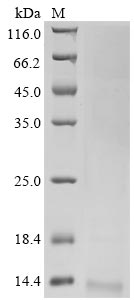Recombinant Avian infectious bronchitis virus Non-structural protein 3b (3b) is produced in yeast, covering the full-length expression region from 1 to 64 amino acids. The protein carries a C-terminal 6xHis-tag, which helps with purification and detection. SDS-PAGE analysis shows it achieves a purity level exceeding 90%, which should ensure high-quality results for research applications. This product is intended strictly for research use and not for clinical applications.
Non-structural protein 3b from the Avian infectious bronchitis virus appears to play a role in the virus's replication and assembly processes. As part of the viral machinery, it may be crucial for understanding the lifecycle and pathogenicity of IBV. Research on this protein could provide insights into viral replication mechanisms, potentially offering valuable information for virology research and therapeutic interventions.
Potential Applications
Note: The applications listed below are based on what we know about this protein's biological functions, published research, and experience from experts in the field. However, we haven't fully tested all of these applications ourselves yet. We'd recommend running some preliminary tests first to make sure they work for your specific research goals.
The protein 3b is an accessory protein of IBV, and its specific functions and requirements for biological activity (such as interaction partners or specific structural motifs) are areas of ongoing research. The purity information from SDS-PAGE only indicates the molecular weight homogeneity and absence of major contaminants; it does not provide information on the protein's tertiary structure or functional integrity. The Yeast expression system is capable of performing many eukaryotic post-translational modifications, which is advantageous compared to prokaryotic systems like E. coli. This increases the probability that the protein could be correctly folded. However, this is not a guarantee. Therefore, while the use of a Yeast system is favorable, the correct folding and bioactivity of this specific recombinant 3b protein batch must be experimentally verified before it can be confidently used in functional studies.
1. Antibody Development and Characterization
This recombinant IBV non-structural protein 3b can serve as an immunogen for generating polyclonal or monoclonal antibodies. The C-terminal 6xHis tag facilitates purification and can be used for immobilization during antibody screening. The high purity (>90%) helps minimize non-specific immune responses against contaminants. However, it is crucial to note that antibodies generated against this antigen may primarily recognize linear epitopes. If the recombinant protein is misfolded, the resulting antibodies might not effectively recognize the natively folded, functional 3b protein within the context of a viral infection, particularly if the relevant epitopes are conformational.
2. Protein-Protein Interaction Studies
The 6xHis-tagged protein can be used technically in pull-down assays to screen for potential interacting partners. However, the success of these studies is entirely contingent on the correct folding of the protein. If the recombinant 3b is misfolded, its interaction interfaces could be altered or absent, leading to false-negative results (missing true interactors) or false-positive results (identifying non-physiological interactions). Any interactions identified using this recombinant protein must be confirmed using alternative methods, such as co-immunoprecipitation of the native protein from virus-infected cells.
3. Biochemical Characterization and Structural Studies
This purified protein provides material for basic biochemical and biophysical analyses. However, meaningful characterization and structural studies require a correctly folded protein. Techniques like circular dichroism spectroscopy or dynamic light scattering could be used initially to assess the folding state and monodispersity of the preparation. If the protein is misfolded or aggregated, data from these studies would not reflect the properties of the native protein and could lead to incorrect conclusions. The yeast expression system may support proper folding, but this must be verified, not assumed.
4. Viral Protein Detection Assay Development
The recombinant protein can be used as a positive control and standard in assays (e.g., Western blot, ELISA) designed to detect the presence of the 3b protein, as these methods often rely on linear epitopes recognized by antibodies. The defined concentration and purity are beneficial for quantification. However, if the assay aims to detect a specific functional form of the protein (e.g., based on conformational epitopes), the relevance of this recombinant standard would depend on its correct folding.
Final Recommendation & Action Plan
To ensure reliable and meaningful results, a stepwise validation approach is recommended before committing to specific applications. First, prioritize the experimental assessment of the protein's folding state using biophysical techniques such as circular dichroism spectroscopy to analyze secondary structure and size-exclusion chromatography to evaluate oligomeric state and aggregation. If the protein shows evidence of being properly folded and monodisperse, proceed to develop a functional activity assay if possible; however, given that the specific biological activity of IBV 3b is not fully defined and it is a non-structural/accessory protein, establishing a direct functional assay may be challenging. In the absence of a known functional assay, the most feasible and valid applications are those that are less dependent on native conformation, such as using the protein as an immunogen for antibody production (with the caveat that antibodies may not recognize conformational epitopes of the native protein) or as a standard for detection assays targeting linear epitopes. For applications like protein-protein interaction studies, any potential hits must be rigorously validated against the native protein in a viral context.






